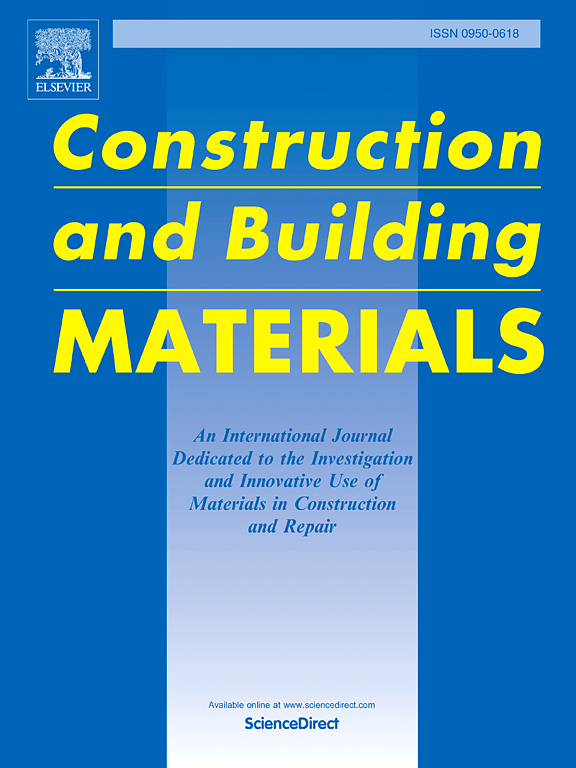Synthesis, characterization, and environmental impact analysis of one-part alkali-activated materials based on alkali-fused basic oxygen furnace slag
IF 8
1区 工程技术
Q1 CONSTRUCTION & BUILDING TECHNOLOGY
引用次数: 0
Abstract
One-part alkali-activated materials (AAM), a low-carbon alternative to cement, can reduce CO2 emissions while improving the utilization of industrial by-products. In this study, basic oxygen furnace slag (BOFS) was activated by alkali fusion with different contents of sodium hydroxide (NaOH), and the optimum NaOH content was selected by the mineral phase composition and micromorphology of alkali-fused basic oxygen furnace slag (ABOFS). Then, ABOFS and ground granular blast furnace slag (GGBFS) were used to prepare one-part AAM pastes, and the effects of GGBFS content on the reaction products, microstructure, leaching characteristics and mechanical strength of one-part AAM pastes were studied. Finally, the life cycle assessment (LCA) of one-part AAM pastes was conducted. The results showed that alkali fusion activation promoted the formation of reactive mineral phases in BOFS and increased its specific surface area. The optimum NaOH content for alkali fusion activation is 10 wt%. The reaction products of one-part AAM pastes primarily consisted of C-(N-)A-S-H gel and hydrotalcite. As GGBFS content increased from 0 wt% to 80 wt%, the amount of gel products first increased and then decreased, peaking at 60 wt%. The addition of GGBFS reduced the porosity of pastes and increased the proportion of gel pores, resulting in a denser structure. Therefore, the compressive strength of one-part AAM pastes increased with the increase of GGBFS. LCA results indicate that the global warming potential (GWP) of one-part AAM is significantly lower than that of ordinary Portland cement. The findings of this study provide new insights into the application of BOFS in AAM.
碱熔碱性氧炉渣单组分碱活性材料的合成、表征及环境影响分析
单组分碱活性材料(AAM)是一种低碳的水泥替代品,可以减少二氧化碳的排放,同时提高工业副产品的利用率。本研究采用不同氢氧化钠(NaOH)含量的碱熔法对碱性氧炉渣(BOFS)进行活化,并通过碱熔碱性氧炉渣(ABOFS)的矿物相组成和微观形貌选择最佳NaOH含量。然后,以ABOFS和磨粒高炉渣(GGBFS)为原料制备单组分AAM膏体,研究了GGBFS含量对单组分AAM膏体的反应产物、微观结构、浸出特性和机械强度的影响。最后,对单组分AAM膏体进行了生命周期评价。结果表明,碱熔融活化促进了BOFS中活性矿物相的形成,增加了其比表面积。碱熔活化的最佳NaOH含量为10 wt%。反应产物主要由C-(N-)A-S-H凝胶和水滑石组成。随着GGBFS含量从0 wt%增加到80 wt%,凝胶产物的数量先增加后减少,在60 wt%时达到峰值。GGBFS的加入降低了膏体的孔隙率,增加了凝胶孔的比例,使膏体结构更加致密。因此,单组分AAM膏体抗压强度随GGBFS的增加而增加。LCA结果表明,单组分AAM的全球变暖潜势(GWP)显著低于普通硅酸盐水泥。本研究结果为BOFS在AAM中的应用提供了新的见解。
本文章由计算机程序翻译,如有差异,请以英文原文为准。
求助全文
约1分钟内获得全文
求助全文
来源期刊

Construction and Building Materials
工程技术-材料科学:综合
CiteScore
13.80
自引率
21.60%
发文量
3632
审稿时长
82 days
期刊介绍:
Construction and Building Materials offers an international platform for sharing innovative and original research and development in the realm of construction and building materials, along with their practical applications in new projects and repair practices. The journal publishes a diverse array of pioneering research and application papers, detailing laboratory investigations and, to a limited extent, numerical analyses or reports on full-scale projects. Multi-part papers are discouraged.
Additionally, Construction and Building Materials features comprehensive case studies and insightful review articles that contribute to new insights in the field. Our focus is on papers related to construction materials, excluding those on structural engineering, geotechnics, and unbound highway layers. Covered materials and technologies encompass cement, concrete reinforcement, bricks and mortars, additives, corrosion technology, ceramics, timber, steel, polymers, glass fibers, recycled materials, bamboo, rammed earth, non-conventional building materials, bituminous materials, and applications in railway materials.
 求助内容:
求助内容: 应助结果提醒方式:
应助结果提醒方式:


